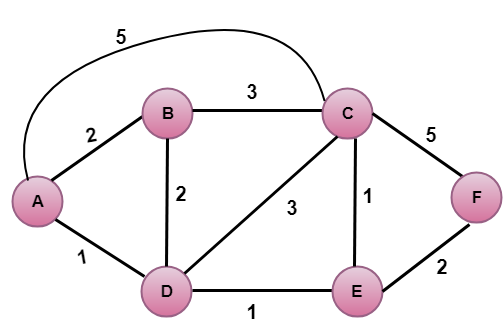Link State RoutingLink state routing is a technique in which each router shares the knowledge of its neighborhood with every other router in the internetwork. The three keys to understand the Link State Routing algorithm:
Link State Routing has two phases:Reliable Flooding
Route CalculationEach node uses Dijkstra's algorithm on the graph to calculate the optimal routes to all nodes.
Let's describe some notations:
Algorithm
Initialization
N = {A} // A is a root node.
for all nodes v
if v adjacent to A
then D(v) = c(A,v)
else D(v) = infinity
loop
find w not in N such that D(w) is a minimum.
Add w to N
Update D(v) for all v adjacent to w and not in N:
D(v) = min(D(v) , D(w) + c(w,v))
Until all nodes in N
In the above algorithm, an initialization step is followed by the loop. The number of times the loop is executed is equal to the total number of nodes available in the network. Let's understand through an example: 
In the above figure, source vertex is A. Step 1:The first step is an initialization step. The currently known least cost path from A to its directly attached neighbors, B, C, D are 2,5,1 respectively. The cost from A to B is set to 2, from A to D is set to 1 and from A to C is set to 5. The cost from A to E and F are set to infinity as they are not directly linked to A.
Step 2:In the above table, we observe that vertex D contains the least cost path in step 1. Therefore, it is added in N. Now, we need to determine a least-cost path through D vertex. a) Calculating shortest path from A to B b) Calculating shortest path from A to C c) Calculating shortest path from A to E Note: The vertex D has no direct link to vertex E. Therefore, the value of D(F) is infinity.
Step 3:In the above table, we observe that both E and B have the least cost path in step 2. Let's consider the E vertex. Now, we determine the least cost path of remaining vertices through E. a) Calculating the shortest path from A to B. b) Calculating the shortest path from A to C. c) Calculating the shortest path from A to F.
Step 4:In the above table, we observe that B vertex has the least cost path in step 3. Therefore, it is added in N. Now, we determine the least cost path of remaining vertices through B. a) Calculating the shortest path from A to C. b) Calculating the shortest path from A to F.
Step 5:In the above table, we observe that C vertex has the least cost path in step 4. Therefore, it is added in N. Now, we determine the least cost path of remaining vertices through C. a) Calculating the shortest path from A to F.
Final table:
Disadvantage:Heavy traffic is created in Line state routing due to Flooding. Flooding can cause an infinite looping, this problem can be solved by using Time-to-leave field
Next Topic#
|
 For Videos Join Our Youtube Channel: Join Now
For Videos Join Our Youtube Channel: Join Now
Feedback
- Send your Feedback to [email protected]
Help Others, Please Share










